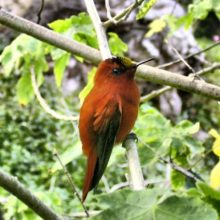Does a congeneric competitor affect the Critically Endangered Juan Fernández Firecrown?
LINKED PAPER
Spatial segregation of the endemic versus non-endemic hummingbird on Robinson Crusoe Island, Chile: the effect of competitor abundance but not resources or habitat. Vizentin-Bugoni, J., J. Sonne, P. Hodum, E. Hagen & J. Cordeiro. 2017. Journal of Ornithology. DOI: 10.1007/s10336-017-1431-1 VIEW
Remote oceanic islands often harbour considerable endemic biodiversity. However, many of these biologically unique places around the world are currently under threat due to human activities. Such activities can generate habitat degradation and invasion by non-native species, such as predators and exotic plants inducing declines of many native species leading ultimately to extinctions.

© Jesper Sonne
Robinson Crusoe (Chile) is one of these islands, located in the middle of the Pacific Ocean, 667 Km from the Chilean coastline. Geographical isolation though millennia has facilitated diversification of many endemic species, including one of the most spectacular and endangered birds on the planet, the hummingbird Juan Fernández Firecrown Sephanoides fernandensis (Figure 1) having a global distribution of 11 Km2 of this single island
Video The Critically Endangered Juan Fernández Firecrown © The Hummingbird Society
Through years of human colonization, suitable habitats of the Juan Fernández Firecrown (Figure 2) have been considerably reduced due to destruction of the native vegetation and degradation of native ecosystems due to livestock. Exotic timber plantations, and introduced plants, especially Rubus ulmifolius, Ugni molinae and Aristotelia chilensis, which out-compete and displace native vegetation. Introduced predators such as cats and rats substantially impact the mortality of birds by preying on eggs, nestlings and adults visiting flowers on the village gardens. These are currently considered the main threats to the Juan Fernández Firecrown, which is globally listed as Critically Endangered, with an estimated population of less than 1000 individuals.

NGOs like Oikonos have conducted ecosystem restoration and, along with the 900 residents currently living on the island, are trying to save this iconic hummingbird and several other endemic species. However, not all threats are anthropogenic. Another hummingbird, the congeneric Green-backed Firecrown Sephanoides sephaniodes (Figure 1) self-colonized the island, likely in post-industrial times. Now, the only two species in the genus Sephanoides share the island, but their coexistence is not harmonious. As is true for many closely related species, they are quite similar in morphology and ecology; both species are territorial and defend patches of floral resources against intruders. Such ecological similarities make these species particularly prone to competition, which would represent an additional threat to the endemic firecrown. Despite this speculation, the few data previously collected did not support the idea that competition between the two species is a problem.
Importantly, research opportunities on remote islands such as Robinson Crusoe may be limited due to costs and logistics, thereby limiting the assessment of the biological patterns which may be important to the establishment of conservation measures. In this context, short focused studies addressing specific questions may be valuable.
During a short visit to Robinson Crusoe Island, we searched for evidences of competition between the endemic and continental hummingbird species. Specifically, we explored whether the spatial distribution of one species was related to the distribution of the other. For that, we counted the number of individuals of each species in 27 point counts distributed within suitable habitat types (Figure 3).

As expected, we found that the local abundances of the two species are negatively correlated, meaning that in places where Green-backed Firecrowns are present and abundant, the Juan Fernández Firecrown is absent or rare (Figure 4). In addition, we found that this pattern was not related to either habitat type or floral resources availability. The detected spatial segregation is a common outcome of competition, suggesting that the spatial distribution of one species depends on the distribution of its competitors.

© Jesper Sonne
In summary, we show that the two resident hummingbird species of Robinson Crusoe Island exhibit spatial segregation during the non-breeding season, arguably as a consequence of interspecific competition. Despite the fact that Green-backed Firecrowns usually lose direct confrontations against Juan Fernández Firecrowns, they vastly outnumber the endemic species (in a proportion of 4:1), which possibly imposes competition for nectar and high energetic costs to defend feeding territories.
Our empirical findings are consistent with the hypothesis that competition with the recently self-colonized S. sephaniodes may limit the population size of the endemic S. fernandensis, which is currently undergoing a population decrease of 1-9% per decade.
References and further reading
BirdLife International 2016. Sephanoides fernandensis. The IUCN Red List of Threatened Species 2016: e.T22687863A93172411. VIEW
Colwell, R.K. 1989. Hummingbirds of the Juan Fernández Islands: natural history, evolution and population status. IBIS 131: 548–566. DOI: 10.1111/j.1474-919X.1989.tb04790.x. VIEW
Wolf, C. & Hagen, E. 2012. Aggressive interactions of firecrowns (Sephanoides spp.; Trochilidae) during the breeding season on Robinson Crusoe Island, Chile Ornit. Neotrop. 23: 545–553. VIEW
Image credit
Featured image: Juan Fernández Firecrown Sephanoides fernandensis | Héctor Gutiérrez Guzmán | CC BY-NC 2.0
If you want to write about your research in #theBOUblog, then please see here.




